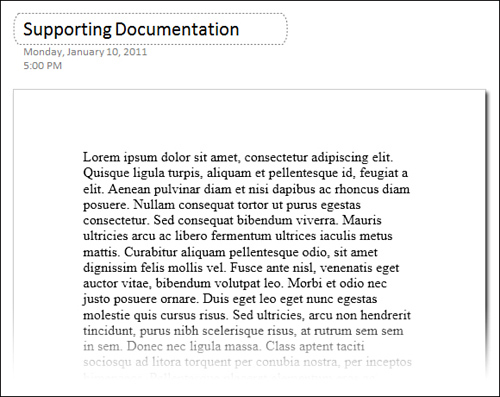Inserting a File Printout on a Page
An alternate way to import content from a file on
your computer into OneNote is to make it appear on your notes page like
a printout on paper. This ensures that there’s no confusion between an
imported copy of a file and its original version on your hard drive,
because the imported copy appears as a static image that cannot be
edited.
Although this might seem limiting compared with
importing an actual copy of a file, this option has two benefits.
First, the layout and appearance of the original file is preserved
perfectly, much like a PDF document would appear on your screen.
Second, the images of the printout can be annotated with typed or
handwritten text or with drawings, offering a much more flexible way to
review and annotate content, especially when reviewing it together with
other people.
To insert a file as a printout, follow these steps:
1. | On your notes page, click to activate the cursor where you want the file printout to begin.
|
2. | On the ribbon, click the Insert tab.
|
3. | In the Files group, click File Printout.
|
4. | In the Choose Document to Insert dialog box that opens, navigate to the folder containing the file you want to print to OneNote.
|
5. | Click
to select the file and then click OK. Depending on the size of the file
and the processing speed of your computer, a progress indicator might
briefly appear. When it reaches 100%, one or more static images
resembling the page (or pages) of your “printed” file appears on your
notes page (see Figure 2).

|
|
If the terminology here is confusing you, let me be
absolutely clear: A so-called “printout” of a file that you’ve inserted
into your notes in OneNote never actually uses your printer in any way.
It’s just a figure of speech to explain how a computer file is sent to
OneNote, where it appears as an inserted image, looking much the same
way as the file would look had you actually printed it out on paper.
|
File printouts can be easily annotated by setting
their images as the page background and then clicking over the image to
create a notes container that holds your text annotations and other
notes about the file’s content. This is especially useful when
reviewing visual content, such as the slides in a PowerPoint
presentation deck.
Another convenient imaging feature to remember for
file printouts is the Copy Text from Picture command that’s available
whenever you right-click an inserted picture. In the case of file
printouts, the images offer two slightly different commands on the
right-click menu—one for copying text from just the selected image (or
page) of the printout, and another for copying all text from all of the
images (pages) in a file printout. Just like with regular images, this
lets you copy the file’s text and paste it into an editable annotation
where you can then revise it with your proposed changes